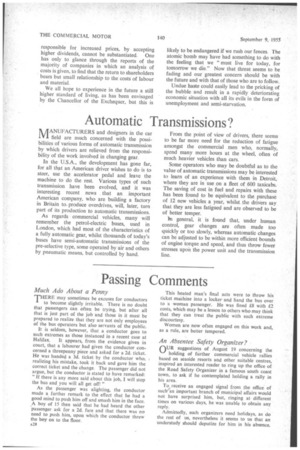Automatic Transmissions?
Page 30

If you've noticed an error in this article please click here to report it so we can fix it.
I\4ANUFACTURERS and designers in the car field are much concerned with the possibilities of various forms of automatic transmission by which drivers are relieved from the responsibility of the work involved in changing gear.
In the U.S.A., the development has gone far, for all that an American driver wishes to do is to steer, use the accelerator pedal and leave the machine to do the rest. Various types of such transmission have been evolved, and it was interesting recent news that an important American company, who are building a factory in Britain to-produce overdrives, will, later, turn part of its production to automatic transmissions.
As regards commercial vehicles, many will remember the petrol-electric buses, used in London, which had most of the characteristics of a fully automatic gear, whilst thousands of today's buses have semi-automatic transmissions of the pre-selective type, some operated by air and others by pneumatic means, but controlled by hand. From the point of view of drivers, there seems to be far more need for the reduction of fatigue amongst the commercial men who, normally, spend many more hours at the wheel, often of much heavier vehicles than cars.
Some operators who may be doubtful as to the value of automatic transmissions may be interested to learn of an experience with them in Detroit, where they are in use on a fleet of 600 taxicabs. The saving of cost in fuel and repairs with these has been found to be equivalent to the purchase of 12 new vehicles a year, whilst the drivers say that they are less fatigued and are observed to be of better temper.
general, it is found that, under human control, gear changes are often made too quickly or too slowly, whereas automatic changes can be adjusted to be within more efficient bounds of engine torque and speed, and thus throw fewer stresses upon the power unit and the transmission line.




























































































